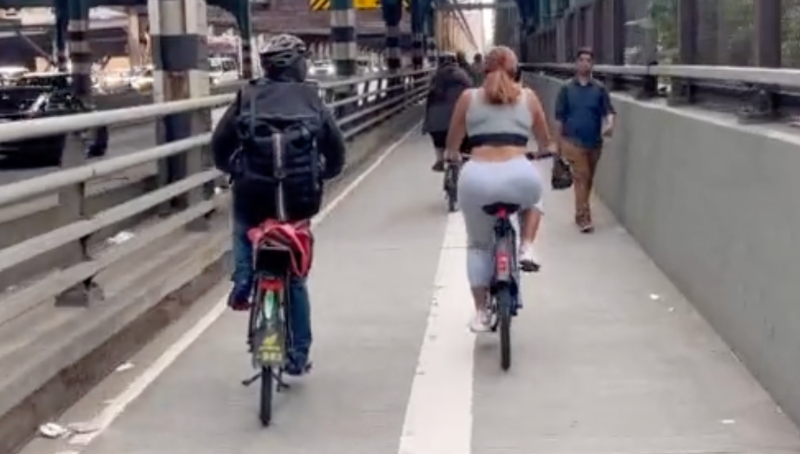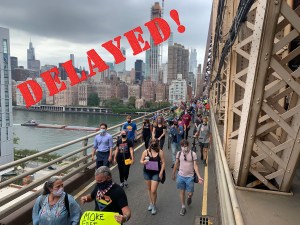Queensboro Bridge Bike Numbers Soaring as DOT Stalls Separate Walking Path

If you don’t build it, they’ll still come.
Bike trips over the Queensboro Bridge increased every month of this year, but the city continues to force cyclists to share a cramped two-way path with pedestrians, as officials delay allocating more room for another year because they fear making drivers wait a little more.
“The bridge is more crowded and chaotic than ever,” said Laura Shepard, a Queens organizer with Transportation Alternatives who regularly bikes the span. “Prioritizing the convenience of drivers over the safety of cyclists and pedestrians is unacceptable.”
Nearly 200,000 cyclists crossed the bridge in May — up 17 percent from the year before and 65 percent higher than in May 2019, according to DOT stats.
Numbers for January and February basically doubled year-over-year, soaring 112 percent and 91 percent respectively, likely due to the unusually warm start to this year, and four out of the first five months had double- or triple-digit percentage increases.
620pm inbound QBB #bikeNYC this is so dangerous. #WidenLanesNow @OpenPlans @bikenewyork @NYCMayor @NYC_DOT pic.twitter.com/c2HOyoWTEQ
— Streetfilms (Now 1,100 films strong!) (@Streetfilms) June 5, 2023
Last year, the Queensboro topped all other East River bridges for bike trip increases (except for the Brooklyn Bridge, but that overpass got a completely new protected bike lane that now keeps cyclists away from pedestrians).
The numbers show an encouraging rise in Queens residents and Manhattanites choosing better modes of transportation, but they are still relegated to the shared north outer roadway that is so crowded that there are frequent crashes.
The Department of Transportation was supposed to move pedestrians onto the south outer roadway by the end of 2022, but has repeatedly held off on closing that shoulder to cars, waiting until it wraps a lengthy rehabilitation of the 114-year-old connector’s upper deck, most recently moving back the deadline to mid-2024 citing “supply chain” issues.
DOT tied the pedestrian upgrades to its larger construction project because transportation officials worried that closing the southern roadway to cars could cause “major traffic delays” in Manhattan, on top of the one or two lanes the agency already closes for the span’s renovations (the bridge has a whopping nine lanes for cars).
But DOT officials have also revealed that they only estimate about 5 percent more cars waiting to go to Queens on weekdays without the south shoulder.
“This is a judgment call they could make tomorrow,” Shepard said. “Letting people walk on the south outer roadway now even before the upper deck construction wraps up would be feasible and safer.”
The advocate was not surprised at the increase in bike trips, given the wider availability of e-bikes making the bridge’s inclines more accessible, and the new bike infrastructure DOT has recently installed leading up and near to the bridge, such as the bike lanes on Skillman and 43rd avenues, or the hugely popular 34th Avenue open street.
“The open street has really contributed to the bike boom because it’s given a lot of people a safe place to learn and practice,” she said.
The other East River bridges also logged increases this year, particularly the Brooklyn Bridge with its much improved bike lane in the roadway that then-Mayor Bill de Blasio opened in 2021. Cyclists previously had to use the boardwalk and navigate around mobs of tourists.
Trips on that span more than tripled during this past warm January from around 17,000 in 2022 to nearly 52,000 crossings in 2023, and continued to grow by 25 percent in May.
The Williamsburg Bridge also went up by 11 percent last month, from around 197,000 in 2022 to 219,000 this year, while the Manhattan Bridge was the outlier, decreasing from 7,965 trips to 5,254 during that time.
The DOT press office did not respond for comment by press time.
